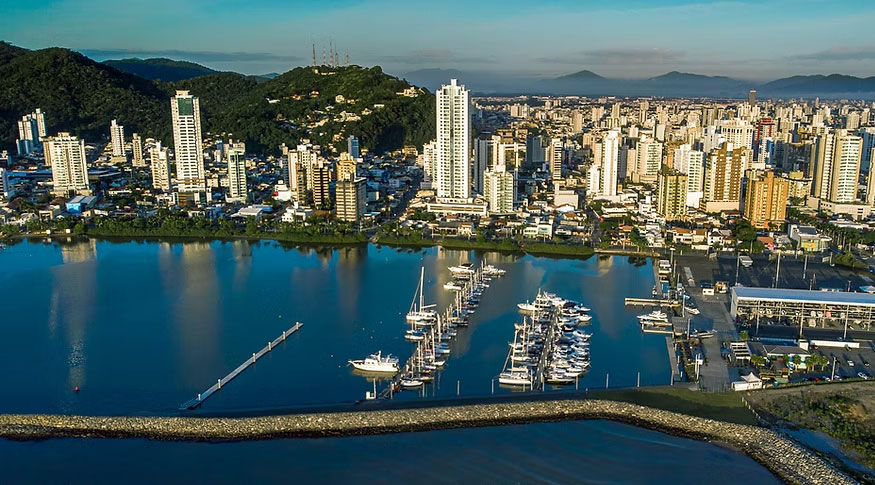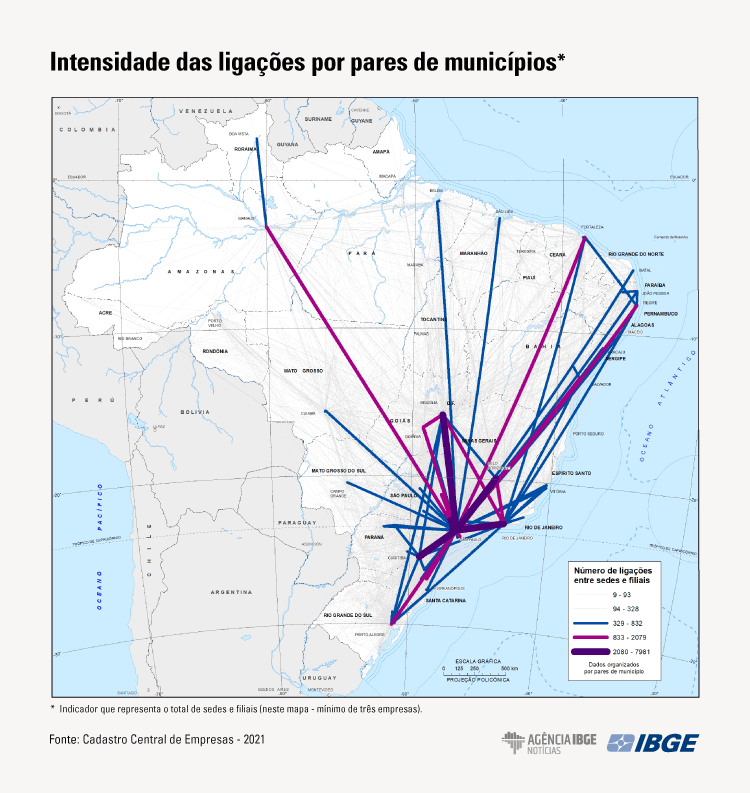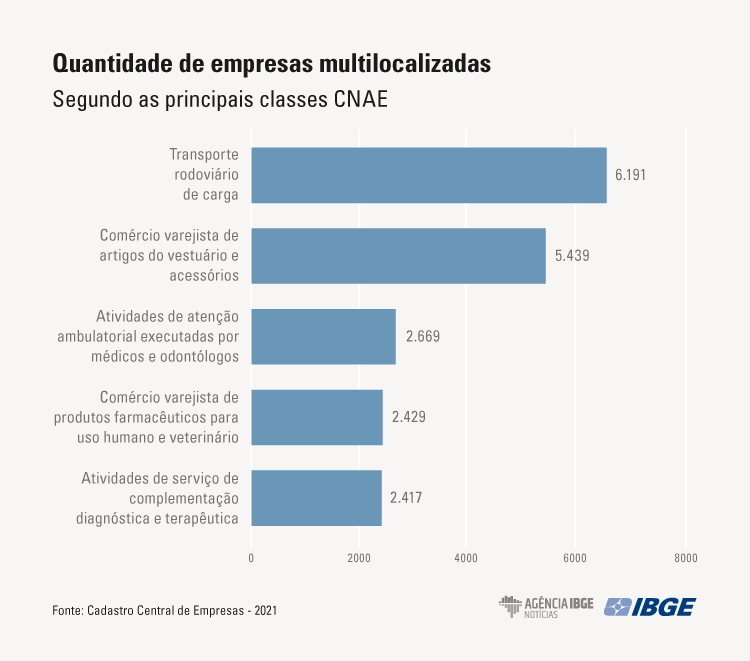Territory Management
São Paulo leads and Itajaí stands out in the territory management ranking
March 26, 2025 10h00 AM | Last Updated: March 30, 2025 01h24 PM
Highlights
- O estudo Gestão do Território, em sua segunda edição, mostra, no universo dos 5.570 municípios do país, quais são os Centros de Gestão, isto é, os responsáveis pelo papel de comando na rede urbana brasileira, tanto do ponto de vista empresarial quanto da gestão pública.
- Em 2024, apenas 39,1% dos municípios do Brasil se qualificavam como Centros de Gestão do Território (2.176 municípios), total ligeiramente inferior aos 39,6% (2.204 municípios) identificados no estudo realizado em 2014.
- São Paulo (SP) é o município que detém a primazia da Gestão Empresarial, seguido do Rio de Janeiro (RJ) e Brasília (DF). Barueri, Osasco e Guarulhos, municípios da área metropolitana de São Paulo, também possuem posições relevantes no mesmo ranking, realçando a centralidade da metrópole paulista.
- Em 2012, as empresas multilocalizadas (aquelas que estão presentes, simultaneamente, em diversos pontos do território, com suas unidades instaladas em diferentes municípios) eram 1,86% do total de empresas pesquisadas e passaram para 2,18% em 2021. Apesar do pequeno percentual, em 2021 estavam presentes em 99,9% dos municípios, demonstrando expressiva capilaridade.
- Em 2021, das cinco principais atividades das empresas multilocalizadas, três eram do setor de saúde. O setor de transporte foi o principal destaque nesse ano, seguido do comércio varejista de vestuário, invertendo a ordem apresentada em 2012.
- Brasília (DF) se destaca como principal centro da Gestão Pública, seguida do Rio de Janeiro (RJ), São Paulo (SP) e Recife (PE).
- O topo da Gestão do Território corresponde à tríade de municípios São Paulo (SP), Rio de Janeiro (RJ) e Brasília (DF).
- Campinas (SP) é o único município que não é capital entre os que ocupam maior posição na hierarquia da Gestão do Território.
- Ainda sobre o indicador Gestão do Território, Itajaí (SC) é o município de maior valor dentre os municípios que não são capital nem componente de metrópole, ocupando a 26ª posição no ranking nacional. Esse resultado foi impulsionado principalmente pelo desempenho de Itajaí no indicador de intensidade empresarial, ao abrigar um número expressivo de sedes e filiais de empresas multilocalizadas, superando até mesmo o indicador de capitais estaduais como Manaus (AM), Cuiabá (MT) e Belém (PA).

In 2024, only 39.1% of the Brazilian Municipalities were classified as Centers for Territory Management (2,176 municipalities), a figure slightly lower than the 39.6% (2,204 municipalities) identified in the study of 2014. São Paulo (SP) remains on top of the ranking, followed by Brasília (DF) and Rio de Janeiro (RJ), which also remained in the same positions in the national ranking. The result evidences the leading role of the three municipalities in the Brazilian urban network, both from the business perspective and from the perspective of public management. Itajaí (SC) is the main municipality among the non-capitals and those that are not in a metropolis.
These data are found in the survey Territory Management 2024, released today (26/3), which identifies the Management Centers found in the 5,570 municipalities in the country. The study presents aspects about Business Management, with a focus on municipalities and business activities connected to other municipalities; and aspects about Public Managehierarchical networks in management of a series of public institutions with decentered units, at federal and state levels.
According to Marcelo Motta, manager of the survey, infomation is important to identify the urban centers that concentrate leading and control capacity in the country and to understand how the different cities are connected by means of territory management networks:
“Distance relationships of economic and political agents help define the role of cities. On the one hand, the State, by means of public agents, serves the population, raises data, collects taxes, executes public policies. On the other, companies, in order to guarantee their profits, will put into practice strategies aiming at action and organization in that space.”
In spite of representing a small percentage of the total (2.2%), in 2021 multi-location businesses were present in 99.9% of the municipalities
The section of the survey on Business Management covers municipalities with business activities that work in association with other municipalities, and the pairs of cities that work in closer connection. So, in order to understand these relations, the study covered multi-location companies: these that can be found, simultaneously, in different parts of the territory, with branches located in different municipalities. So, the selection from the Central Registry of Enterprises includes companies with at least a branch in a municipality other than the one of its headquarters.
In 2012, multi-location companies made up 1.9% of the total businesses surveyed and reached 2.2% in 2021. In spite of representing a small percentage of the total, in 2021 they were found in 99.9% of the municipalities. Between 2012 and 2021, the percentage of participation of these companies compared to the company overall changed by 0.3%, from 1.9% (2012) to 2.2% (2021). As for relative growth, however, whereas the company overall grew by 13.0% in the same period the multi-location ones recorded and increase of 32.5%.
According to the manager of the survey, the reasons for the increase of multi-location companies were not directly identified by the survey. “These are often complex processes with multiple causes, such as merging and acquisition, which lead to the increase of retail chains, or the increase of relevance of cargo transportation and logistics , given the expansion of e-trade,” he explains.
In regional terms, the Southeast Region has the biggest concentration of multi-location companies (45.4%). Nevertheless, from 2011 to 2021, concentration fell in the Southeast and South Regions and increased in the other Major Regions, where the Northeast stands out, with a change from 15.3% local branches, in 2011, to 17.0%, in 2021.
São Paulo (SP) holds primary role in Business Management in 2021
Once relationships are established between municipalities, the survey calculated the intensity of connections per minute, which is an indicator formed by the sum of the number of headquarters and branches of multi-location companies for all Brazilian municipality. The bigger intensity attributed to a municipality, the bigger their interactions with the others, no matter the distance between them.
“We do not take into consideration if the company is the headquarters or a branch. Both have the same weight, because, that way, a municipality that concentrates many headquarters obviously concentrates power, but the municipality that concentrates many branches also has some relevant centrality. The branch can be only an executor, a research and development center, a very important place,” Marcelo explains.
According to Evelyn Pereira, deputy manager and survey assistant, the objective is to see how these municipalities behave in chain. “Is it an important piece in that chain? Is the municipality, from the business perspective a reference to several others? That’s what intensity means,” she adds.
The analysis of the intensity of connections by pairs of municipalities (connections between headquarters and branches) shows the highest value is found in the São Paulo (SP)-Rio de Janeiro (RJ) pair.

Due to its links, São Paulo (SP) is the municipality witth a primary role in Business Management in 2021, followed by Rio de Janeiro (RJ) and Brasília (DF).
Barueri, Osasco and Guarulhos, municipalities located in the metropolitan area of São Paulo, also have relevant positions in the same ranking, which highlights the centrality of that metropolis.
In one decade there was little change in the representation of municipal centralities, but it is possible to register their progress in the national ranking of intermediate centralities, such as Cuiabá (MT), Belém (PA), Manaus (AM) and, mainly, Itajaí (SC), which has a significant number of headquarters and branches of multi-location companies.
In 2021, three of the five main activities of multi-location companies belonged to the health sector
As for the sectors of activity of multi-location companies, biggest concentrations were found in trade (43.8%) and services (36.2%), ahead of industry (16.7%) and agriculture and mining and quarrying (3.3%). In terms of activities, in 2021, three of the five min ones belonged to the health sector. Transportation was the main highlight this year, followed by retail trade of wearing apparel, a reversal of the order observed in 2012.
In 2012, four of the five main activities of headquarters of multi-location companies belonged to the retail sector, whereas, nowadays, only retail trade of wearing apparel and accessories stands out. The Transportation sector has gained relative importance, which may be related to the expansion of online trade and the demand for delivery of goods.

“The increase in transportation of cargo was already expected. The first position was occupied by retail trade of wearing apparel and accessories at first, which is something important until today. That makes complete sense, thus, when that is associated to the distribution of products purchased online, and consistent with the fact that cargo Transportation is very dynamic and needs decentered units in several municipalities,” Evelyn explains.
Still according to the researcher, pharmaceutical activities stand out, including ambulatory care provided by physicians and odontology professionals, clinic chains, pharmaceutical products (for people and animals), complementary diagnosis services and therapies, among others.
In 2021, São Paulo was the municipality with the biggest number of external salaried persons, with an increase of 17.4% from 2012
It is also possible to measure the status of business connections between municipalities by means of the number of external salaried persons to the headquarters of the company. To reach this objective, the survey investigated the total number of employees working in establishments (factory, retail shop, retailer, bank agency, etc.) of a company whose headquarters is located in a different municipality.
In 2021, São Paulo (SP) was the municipality with the biggest number of external salaried persons (1,855,722), which means an increase of 17.4% from 2012. Among the ten municipalities leading this item, Rio de Janeiro (RJ) stood in second place, with 486,696 external salaried persons, followed by Brasília, with 315,047.
Among the cities which recorded relative increase in the number of external salaried persons, Itajaí (SC) stands out, due to its industrial sector and port/naval center. Besides, the municipality gathers a significant number of headquarters and branches of multi-location companies, overcoming the number of state capitals such as Belém, Manaus and Cuiabá.

Brasília is the main public management center in the country, followed by Rio de Janeiro, São Paulo and Recife
Another topic in the survey is Public Management. It analyzes territorial structures of work in the State, based on the connection of networks of urban centers, having as a reference the work of public power and the hierarchical connection between municipalities, forming a sequence of subordinated elements that may reach federal level.
“Our premise is that the State organizes the geographical space by means of its organizations, both directly and with public institutions decentered in cities. And this distribution of public bodies generates decision capacity and shows the way the State organizes its own space,” Marcelo says.
The main urban center responsible for public management in Brazil is Brasília (DF), federal capital and national headquarters of most public institutions, and that holds, alone, a position of centrality in public management, working as the main manager of the state administrative structure. Rio de Janeiro (RJ) is in the second position, which may result from the fact it still has a number of public institutions from the period when it was the federal capital. São Paulo and Recife complete the list at the second level in public management.
The first three levels of centrality in public management are exclusively occupied by municipalities that are metropolis centers. Together, they are the most influential urban centers in Brazil, besides concentrating most of the population. The Northeast Region has the biggest percentages of municipalities that are not Public Management Centers (31.5%) at a low centrality level (37.8%).
Ranking of Municipalities, by levels of centrality in public management
| Public Management Levels | Municipalities |
|---|---|
| 1 | Brasília (DF) |
| 2 | Rio de Janeiro (RJ) |
| São Paulo (SP) | |
| Recife (PE) | |
| 3 | Belo Horizonte (MG) |
| Porto Alegre (RS) | |
| Curitiba (PR) | |
| Fortaleza (CE) | |
| Salvador (BA) | |
| Belém (PA) | |
| Florianópolis (SC) |
To create the Federal Management chart, the survey selected a group of multi-locations institutions: IBGE, INSS, Federal Justice, Ministry of Employment and Labor, Federal Revenue, Electoral Justice and Labor Justice. Among those, the Electoral Justice has greater territorial coverage, being present in 2,028 municipalities.
As for State Management, State Education and State Health Secretariats were considered. A total of 528 municipalities received a reinforcement in the indicator of centrality in public management due to their role in state management. Thus, due to the contribution from this this indicator, 25% of the Public Management Centers were better qualified, mainly in medium-sized municipalities with a relevant influence in state contexts.
Itajaí (SC) occupies the 26th position in the territory Management ranking
The municipalities classified as Territory Management Centers are those that have, simultaneously, entities of decentered public institutions and local facilities of multi-location companies, either headquarters or branches. According to this criterion, more than half of the Brazilian municipalities are not entitled to this classification, as only 2,176 (39.1%) of the municipalities have both structures.
In 2024, the three municipalities at the highest levels regarding Territory management were São Paulo (SP), Brasília (DF) and Rio de Janeiro (RJ), showing the centrality of the capital in Business Management, of Brasília cin Public Management and Rio de Janeiro a number two in both types of management.
About this indicator, Itajaí (SC) municipality of highest value among non-capitals or non-metropolis, placed at the 26th position in the national raking. This result was mainly influenced by the performance of the municipality in the business intensity index, due to its significant number of headquarters and branches of multi-location companies, even surpassing the indicator of capitals such as Manaus (AM), Cuiabá (MT) and Belém (PA).
“There is great strength in the state of Santa Catarina, which is not restricted to the capital. That raises a lot of interest, because cities in inner parts of states have played a greater economic and political role, says Evelyn. Marcelo highlights the significant role of the urban network in Santa Catarina, differently from other states, which are centered in the capital: “In Santa Catarina, examples are Chapecó, Joinville and Itajaí. There is a better distributed urban network.”
In 2024, 2,176 municipalities were classified as Territory Management Centers, a total slightly below the 2,204 surveyed in 2014. The change can be explained by means of the distribution of electoral zones and INSS Branches.
“Most Brazilian municipalities are absolute out of the territory management center. There are 3,394 small municipalities with an average of 8,000 residents. So, there is something that is fed back. The greater territory management, the higher municipal hierarchy and the more attractive it becomes to new activities,” Marcelo added.
More about the survey
Territory Management 2024 identifies management Centers existing in the universe of 5,570 municipalities in the counrty, that is, municipalities that have a leading position in the Brazilian urban network, from the perspectives of both business management and of public management. The survey deals with data from the IBGE's Central Registry of Enterprises - CEMPRE, relative to the years of 2020 and 2021, including the municipal location of local facilities of branches or headquarters.As for public management studies, data are relative to the year 2024, and the political administrative division of Brazil adopted was that of 2024.
This is the second edition of the study. The reference year for the first one was the year 2012. It also highlights that the study about the territory was also included in the publication Regic 2018.
Data are available in a database formed by two grous of tables, found in the IBGE's Interactive Geographic Platform.




















